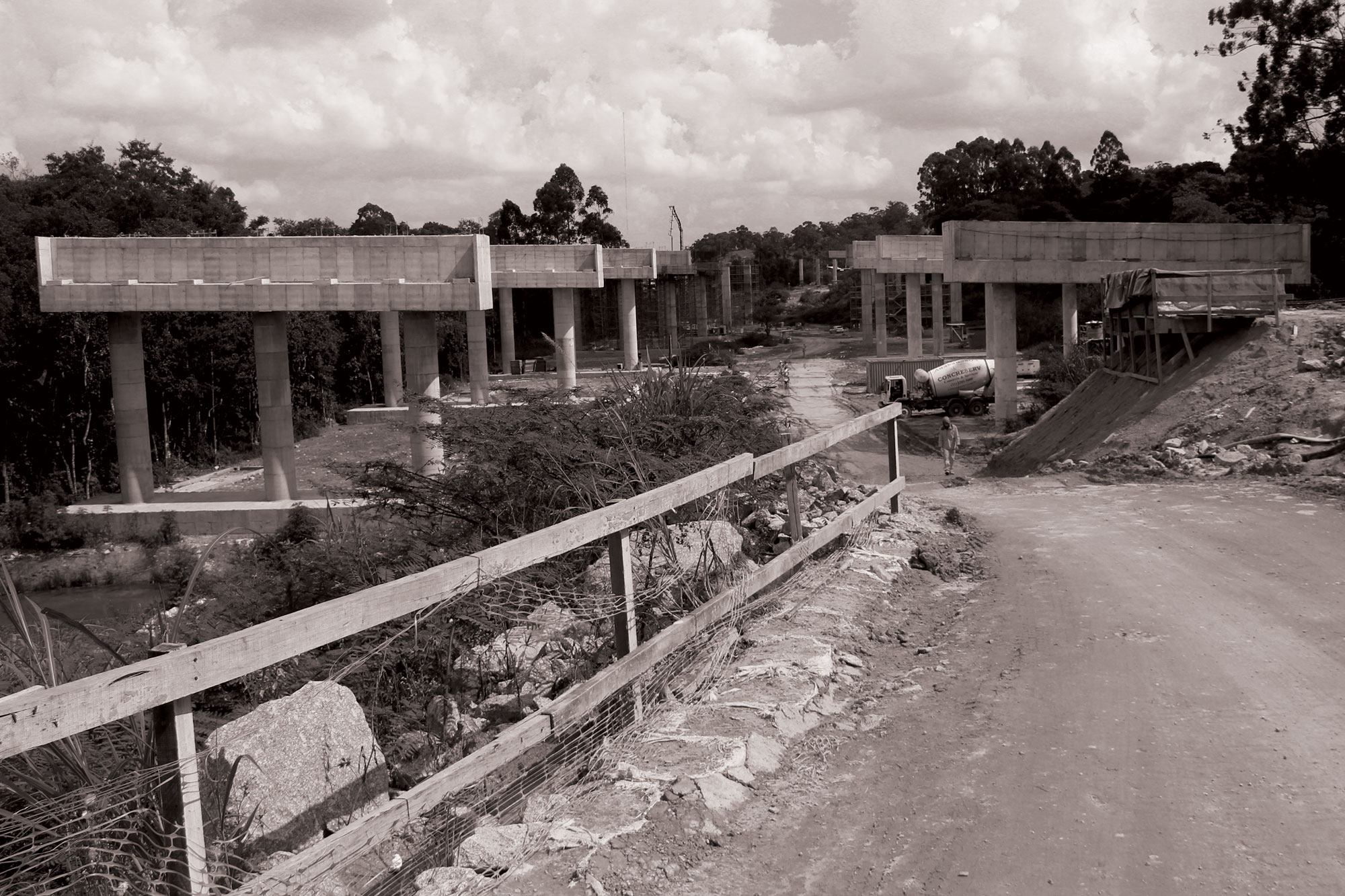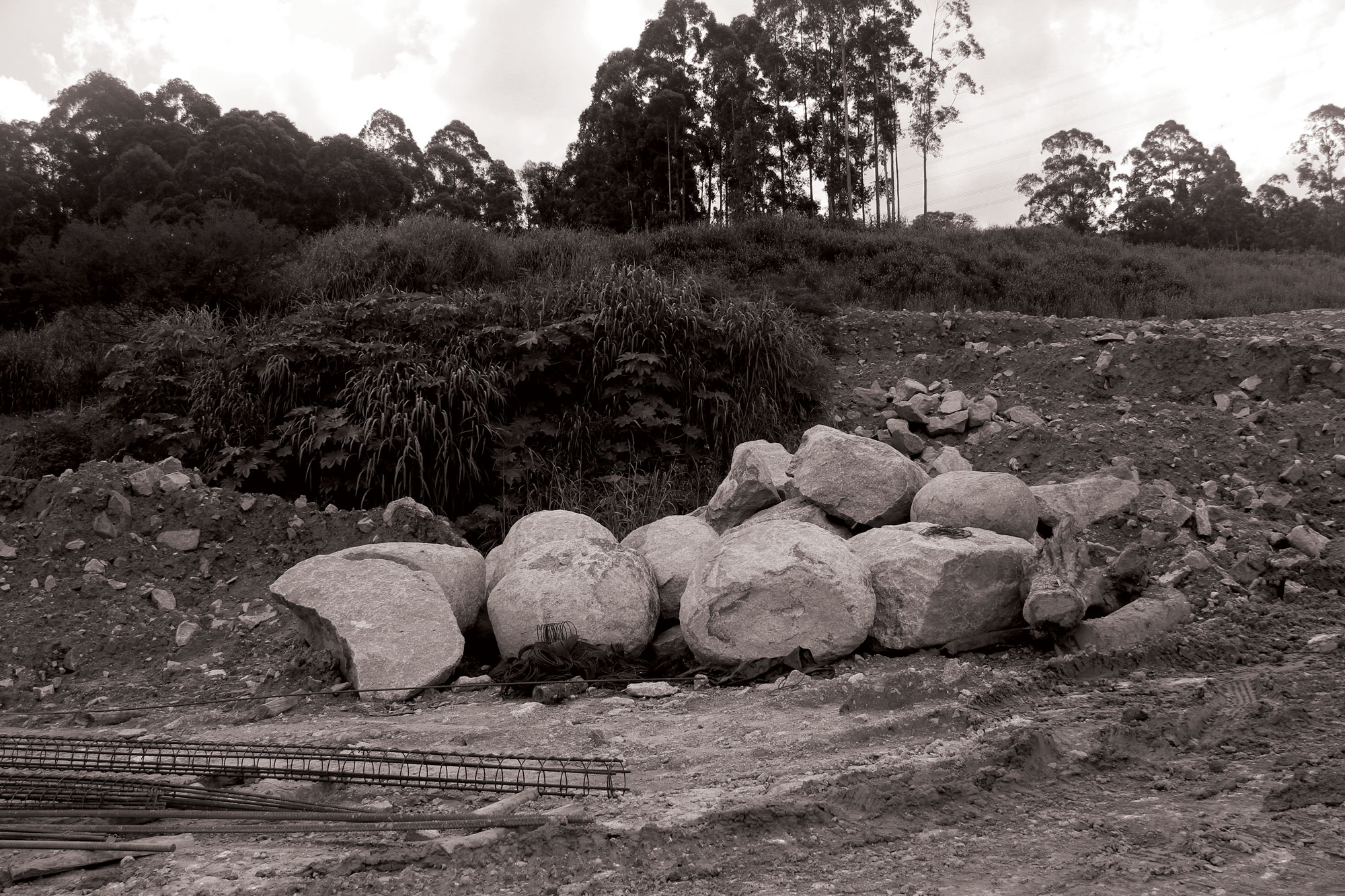Techno-political pacts in urban vectors
closeThe extensive urban growth and occupation of the territory witnessed in metropolises such as São Paulo sees no physical or social obstacles nor the establishment of boundaries. Within this scenario, mobility and accessibility are the founding principles and not the outcomes of such expansionist processes. In the case of São Paulo this is spatialized through a model of metropolitan organization structured in a radiocentric scheme. The logic of ‘road-rings’ was established with the Avenues Plan proposed by Prestes Maia in 1930, followed by the construction of the Pinheiros and Tiete riverside roads, proposed by Robert Moses in 1950, which is an analogous strategy to what is implemented today with the construction of the Rodoanel, the Greater São Paulo Beltway.
Construction of a section of Rodoanel Mário Covas, the Greater São Paulo beltway, Brazil, 2015. Photos by Daniel de Paula, courtesy of the artist.

The design and construction of these major infrastructures result from the division of tasks between the public and private sectors. The first is responsible to mobilize investment resources, manage the overall planning of the intervention areas, and promote the bidding process for the hiring of companies. Whereas the private sector is accountable for the preparation of technical projects and for the execution and management of the construction-work. The government of São Paulo is one of the largest claimants of public works in the country having been responsible for fostering the growth of construction companies based in the state. The only segment to gather all macro-contractors is the heavy-constructions, whose main actors are companies such as Andrade Gutierrez, Mendes Júnior, Odebrecht, Camargo Corrêa, OAS, among others.1 This relationship between the state and large construction corporations has been carefully nurtured over the years in order to enable the creation of favorable conditions for constituting and maintaining a solid market for the sector.

(...) Such conditions include financial mechanisms and institutional structures created by the state, especially in the field of road construction, which increased the capitalization of the emerging engineering firms and opened a proper political space to represent the interests of contractors. In result, we are faced with unconventional forms of ‘stimulus’ to the heavy construction sector such as the overestimation of service prices, the ‘a posteriori’ adjustment of the values of contracts and the interference by the contracting organization in competition proceedings, aimed at favoring certain firms or consortia. All these stimuli and measures reveal the centrality of the political element in order to obtain success in business in the field of heavy engineering. Prior to relating to factors of a strictly economic order, the performance of contractors depends on having good connections with the public bodies and the ability to make ‘arrangements’ in the works, that is, to transform the contract into a good deal.
These ‘arrangements’ go beyond the simple co-optation of the state apparatus by corporate interests. Instead, what is established is a ‘bureaucratic-entrepreneurial’3 pact that is favorable to both parties. On the one hand, companies have their survival tied to victories in the market of public works, on the other, the heavy construction industry, in particular the transport infrastructure, is also beneficial to the State as an instrument of implementation of macroeconomic policies. For example, construction-works have the ability to energize the real estate market, by opening up new areas for urban expansion and strengthening the attractiveness of these areas for businesses and industries. Furthermore, large works of urban mobility are political achievements, since they ideologically serve to maintain a progressive image created for the city and the country. They also give legitimacy to the exercise of power because they enhance the visibility of the governments' practices. A visibility which is strategically intensified in periods of electoral campaigns, which are frequently funded by donations from several of the contractors that end up winning the public biddings.4

Subjected to agreements of this nature, the construction of transport infrastructure acquires a meaning that goes far beyond the consideration of their social impact. Even though they hold the potential to instigate greater integration and spatial cohesion, these projects often trigger socio-spatial segregation and urban fragmentation. The improvement of the quality of life through increased mobility and accessibility for some, often happens to the detriment of other parts of the population that are subjected to evictions or unable to afford the overvaluation of the areas in which they reside. This leads to parallel displacements to the ones that are officially promoted by such major transportation axes. This type of techno-political structuring of the territory both urges and benefits from a constant flow of people, places and capital. The land, once a symbol of an intelligible present, increasingly sees its social function eroded by these successive displacements, and by the replacement of its use value by a monetary and political worth.
Construction of a section of Rodoanel Mário Covas, the Greater São Paulo beltway, Brazil, 2015. Photos by Daniel de Paula, courtesy of the artist.

Curatorial text for SITU #2, testemunho by Daniel de Paula, Galeria Leme, São Paulo.
-
These macro-contractors were investigated in the Operation Lava Jato (Car wash), which from 2014 unveiled a corruption network that involved contractors, political parties and public officials. The operation uncovered overbilling maneuvers, cartel crime, contract fraud, illegal donations, bribery and other illegal acts. Since 2019 the legitimacy of the Operation has been questioned and the Car Wash taskforce was officially disbanded on 1 February 2021.
-
CAMARGOS, Regina Coeli Moreira. Estado e Empreiteiras no Brasil: Uma Análise Setorial. Dissertação. IFCH/Unicamp, 1993, p.79, apud IACOVINI, Rodrigo Faria Gonçalves. Rodoanel Mário Covas: atores, arenas e processos, p.19. Translated by the author.
-
Idem, Ibidem, 1993.
-
MARICATO, Ermínia. Formação e Impasse do pensamento crítico sobre a cidade periférica. São Paulo, 2010, no prelo. / IACOVINI, Rodrigo Faria Gonçalves. Rodoanel Mário Covas: atores, arenas e processos. Dissertação FAUUSP, São Paulo, 2013